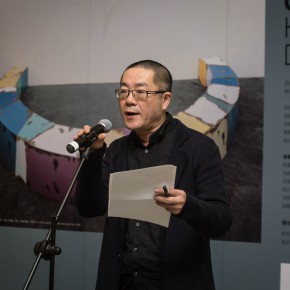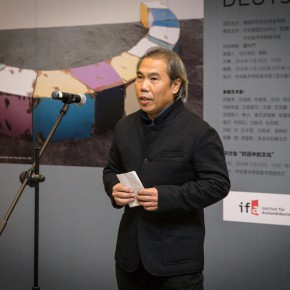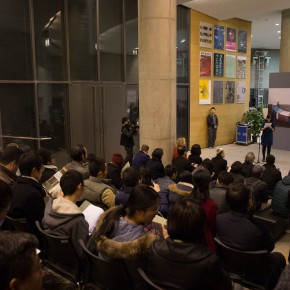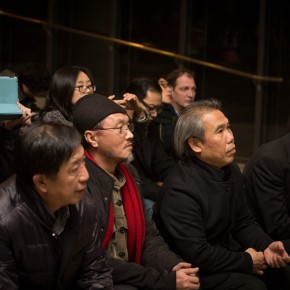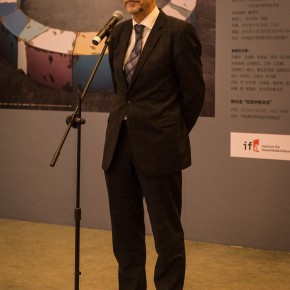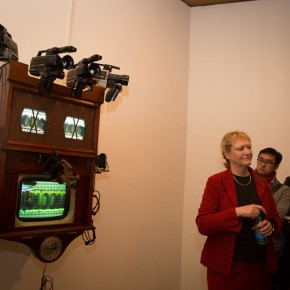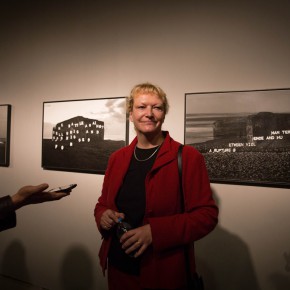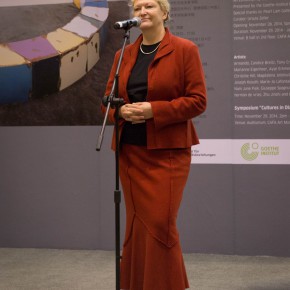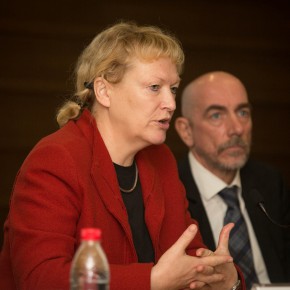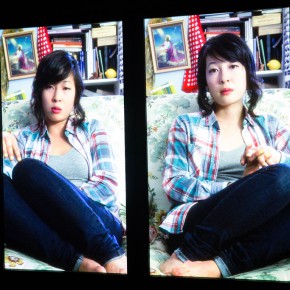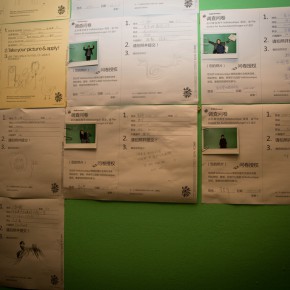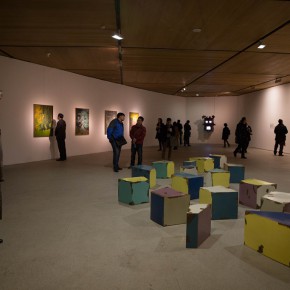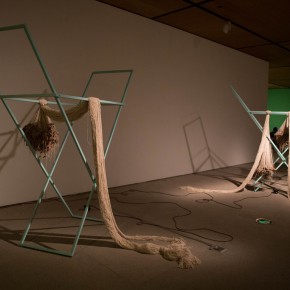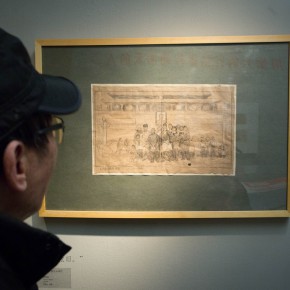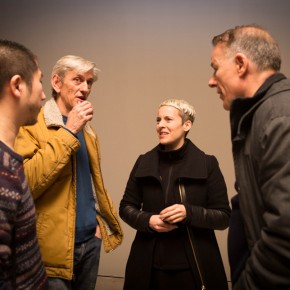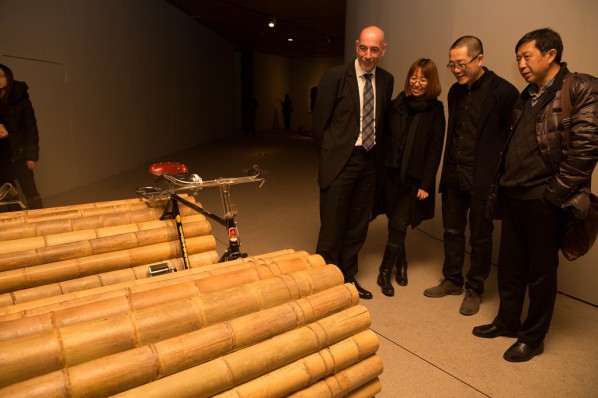
On November 28, 2014, hosted by the German Institute of Foreign Cultural Relations, co-organized by Beijing German Cultural Center • Goethe Institute (China) and CAFA Art Museum, a large-scale art exhibition “Art Space Germany” opened at CAFA Art Museum.
The exhibition showcases groups of cross-boundary work in addition to visual art, by a large number of internationally known artists including Armando, Candice Breitz, Tony Cragg, Marianne Eigenheer, Ayse Erkmen, Christine Hill, Magdalena Jetelová, Per Kirkeby, Joseph Kosuth, Marie-Jo Lafontaine, Nam June Paik, Giuseppe Spagnulo and Herman De Vries, who stand for a myriad of artistic variety to be seen in transcultural unity, while the Beijing show also features Chinese artists Zhu Jinshi and Qin Yufen’s works. In addition to showcasing the works by representative artists of the last 3 decades, the exhibition explores the significance and influence by the artists living and working in Germany to local art circles, focusing on the theme of the “Media and Expressive Way in Current Discussions”.
At 15:30, the press conference was held inthe VIP room of CAFA Art Museum, and presided over by Gao Gao from the Academic Department of CAFA Art Museum, German honored guests including Peter Anders, Head of Goethe Institute China, curator Ursula Zeller, German artist Candice Breitz; Chinese honored guests Wang Chunchen, Director of the Academic Department of CAFA Art Museum and Chinese artist Qin Yufen participated in the conference.
Wang Chunchen said that, from the perspective of CAFA, it reveals that in the current open and globalized China, we need to showcase more multi-cultural art exhibits to Chinese audiences and artists, through changing the topic of the exhibition to Chinese issues, namely: is there a solo and complete artistic characteristic of the country today? Wang Chunchen said:“Although the exhibition is small, it has a profound meaning.”
After that, Peter Anders, Head of Goethe Institute China and curator Ursula Zeller respectively introduced the exhibition in detail from different perspectives.Anders said that this exhibition focused on exploring the influence of foreign artists living in Germany to German art circles, but it also blended the works and position of Chinese artists in the exhibitions in China, trying to emphasize the significance of the dialogue between China and Germany; Ursula Zeller analyzed the current situation in globalization, the exhibition was the first international exhibition within theforeign cultural policy framework in Germany, breaking through the boundaries between a variety of arts, while the artist groups also wholly revealed the diversity of art in the cross-art unit.
At 5:00 pm, the opening ceremony was held in the ground floor staircase hall. Wang Shaojun, Deputy Party Secretary of CAFA, Wang Huangsheng, Director of CAFA Art Museum, Peter Anders, Head of Goethe Institute China, curator Ursula Zeller, Lv Shengzhong, Head of the School of Experimental Art, participating artists Candice Breitz, Qin Yufen and Fan Feng, Director of Wuhan Art Museum attended the opening ceremony.
Wang Shaojun gave an opening speech, he said that, Germany hadalways focused on international artistic exchanges, while CAFA also paid attention to living and studying abroadwhichinfluenced and inspired the creations of the students, and the exhibition was a centralized presentation of the effect after anexchange.
After the opening ceremony, curator Ursula Zeller guided the audience to visit the exhibition.With regard to how to select the participating artists, Ursula Zeller said: “The exhibition reflects the realsituation in Germany. German art world doesn’t want to dismiss theGerman tradition in art, neither does it hopethat non-Western art and Western art are opposites, nor helpthe non-European art rebound in front of European art,which are the ambitions of other exhibitions. Taking fine arts for example, the exhibition aims to showcase the appearance of a cross-cultural atmosphere, these immigrant artists – no matter which region they come from –all introduce a single country with inspiration, enriching and changing it. We select the artists who voluntarily decide to live in Germany. They belong to the first generation of immigrants, bringing different perspectives, knowledge and inspiration from the outside.”
The Europe Union and the global network spanning all the regions of the globe ask every nation in the world a new question of how its culture is to be presented, to be made available to others. The development of the visual arts clearly shows the effects of the blending of cultures: the global village is a reality right now. “Participants in the world”, “Wanderers among the Various Cultures” have become indispensable roles of the artists. As many German artists moved to the art metropolis of Paris in the 1950s or to New York beginning in the 1960s, artists from other nations made a conscious decision to (re)locate themselves and their art in Germany. Their integration can be seen by the fact that they have given new impulses, which are today perceived as an integral part of the art scene here. It is above all these artists who have immigrated to this country, who put their stamp on creative life, together, of course, with their German colleagues. Their integration has brought the German native visual art new inspiration, and naturally has become part of the local art. Together with German artists,foreign artists - especially German immigrant artistsprofoundly impacton the art creation and life in Germany: they teach at the academies and colleges of art, in turn making them attractive for not only German young people, but those from abroad as well. With regard to the subject of the exhibition, curator Ursula Zeller said, “In addition to showing the representative views in the past 4 decades, it also emphasizes its influence and significance onthe current concerned themes, medium and performances.”
It is as the first stop of the touring exhibition, and continues to January 4, 2015. After that, the exhibition will be taken to Nanjing, Wuhan, Chengdu, Chongqing, Xi'an and Hangzhou by Goethe Institute.
About the exhibition
Duration: November 29, 2014 – January 4, 2015
Venue: Gallery 2B, CAFA Art Museum
Text by Lin Jiabin, translated by Chen Peihua and edited by Sue/CAFA ART INFO
Photo by Hu Zhiheng/CAFA ART INFO


